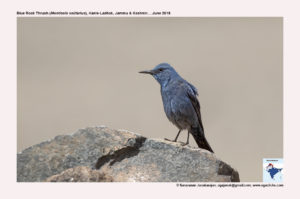Blue Rockthrush

Blue Rockthrush Monticola solitarius
Etymology :
- Monticola : Latin word montis- mountain; cola – inhabitant
- Solitarius : Latin word for “solitary, alone” derived from solus- alone
Vernacular Names :Hindi: Kashmiri kasturi, Sans: Kashmir girikasturika, Kash: Pala tiriv, Pun: Nilikasturi, Lepcha: Ningri-pho, Cachar: Daohangar, Mikir: Vohtigle, Naga: Hengmeruine, Guj: Pandushyama, Nil kasturo, Mar: Nilakastur, M: Pandu, F: Maal, Te: Podakachi pitta, Mal: Parakili, Kan: Neeli thrush
Distribution in India: Resident of Himalayas and widespread winter visitor in India.
Description: Size of 18-20 cm.The male of nominate race is deep blue, darker and browner on wings and tail. The female is variable, much duller blue-grey or brownish above and below it is streaked buff and brown from lower face to mid-breast, shifting to buff-and-brown barring from lower breast to undertail.
Habitat: It breeds on precipitous cliffs, in steep rocky valleys and defiles, ravines and gorges, on crags, outcrops, arid boulder-strewn slopes, sea cliffs and headlands, rocky coasts, ruins, quarries and open mines, isolated stone buildings like churches. It isfound from 500 up to 2000m.
Food habits :It eats Invertebrates like grasshoppers, locusts, crickets, mole-crickets, adult and larval lepidopterans, beetles, ants and flies; also spiders, snails, earthworms, small vertebrates like small lizards, snakes frogs, toads , mice, and fruits. Fruits, berries and seeds, taken mainly in autumn and winter. It forages by scanning from low vantage point and dropping to ground to take prey, also by hopping and running on ground; occasionally flycatches in aerial sallies. It eats fruit direct from plant andalso on ground.
Breeding habits: They breed in Mar–Jul in NW Africa, Apr to Jul in Iberia, Feb to Jun in Israel, Jun–Jul in Afghanistan, Apr–Jul in Himalayas and May–Jul in China. It is double-brooded and sometimes triple-brooded. . The nest is a shallow cup or rough pad of coarse dry grass, rootlets, moss and leaves, loosely constructed and lined with fine soft grass, rootlets and occasional feathers and plant down, placed under rock overhang, in crevice of cliff, rock, bank, cave or building, sometimes tree hole above ground. The nest may be used in successive years. They lay a clutch of 3–6 eggs. The incubation period is 12–15 days and nestling period is 15–18 days. Thepost-fledging dependence of chicks is 2 weeks.